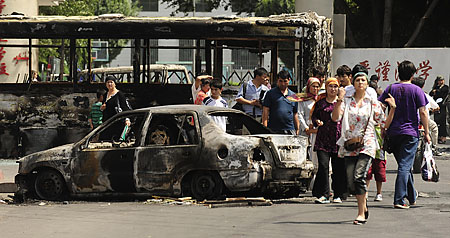
People walk past burnt out cars and buses in a street in Urumqi in China's far west Xinjiang province on July 6, 2009, following a deadly riot. (Photo: Peter Parks - AFP - Getty Images)
The heat of the summer in China’s northwestern region of Xinjiang has been punctuated once again by mass violence. In the oasis city of Hotan, authorities say rioters from the Uighur ethnic group attacked and set fire to a police station on Monday, killing four people including a paramilitary officer, a security guard and two hostages. On Wednesday, state-run Xinhua news agency reported that police responded by shooting and killing 14 rioters, who the agency said threw gasoline bottles and rocks. (Updated July 20, 2011.)
Exile Uighur groups have disputed the official version of events. The Munich-based World Uyghur Congress says that a group of about 100 Uighurs were protesting “illegal seizures of land and the forcible disappearances of relatives by Chinese security forces” when police opened fire, prompting the clash.
(PHOTOS: China Celebrates 90 Years of Communism)
Outbursts of violence have been regular if relatively infrequent events in Xinjiang for the past two decades. In August 2010 a Uighur man who was targeting police and paramilitary officers set off a bomb rigged to a three-wheeled cart, killing seven people and injuring 14. Two years before in the city of Kashgar two Uighur men drove a truck into a group of border patrol officers who were out on an early morning run, then attacked the survivors with knives and homemade explosives. Seventeen guards were killed, and 15 injured.
The largest-scale violence in recent years happened on July 5, 2009, when young Uighur men went on a rampage in the regional capital of Urumqi, attacking non-Uighurs with clubs and knives. Two days later Han Chinese, who are the dominant ethnic group in China, launched retaliatory attacks on Uighur neighborhoods. Nearly 200 people were killed and some 1,700 injured, according to official reports. Tens of thousands of paramilitary troops flooded the city to restore order, and Internet service was blocked, only to be restored months later.
The Chinese government has blamed the Urumqi riots on terrorists groups operating under orders from outside China. There is a small-scale independence movement in Xinjiang, with some people willing to use violence to further their causes. But the bigger worry is the inequality experienced by the Uighurs, a predominantly Muslim, Turkic-language speaking minority group concentrated in the oasis towns of Xinjiang. Uighurs have chafed under Chinese rule, which many say threatens their culture, religion and language. The most consistent complaint I’ve heard from Uighurs over the past few years is that they feel frozen out of the economic opportunities enjoyed by Han Chinese.
(PHOTOS: China Stamps Out Democracy Protests)
After the 2009 Urumqi riots the central government shuffled the leadership of the nominally autonomous region, removing hardliner Wang Lequan from his post as Xinjiang party secretary and installing Zhang Chunxian, a media-savvy official who had previously been party boss in Hunan province. President Hu Jintao later announced plans to bring Xinjiang’s GDP in line with the rest of the nation, pairing Xinjiang cities and counties with richer counterparts in east China as a way to channel funds. But the concept of economic growth as a salve for social woes, which has contributed to China’s success over the past three decades, runs into serious obstacles in Xinjiang. The authorities have said little about the widespread discrimination faced by Uighurs in China. It is not uncommon to hear Uighurs called “thieves” or worse in China, and such bias creates a serious obstacle to Uighurs enjoying a share of the economic opportunity afforded Han Chinese. China may well achieve its growth targets in Xinjiang, but if Uighurs are left behind the ethnic strife will only continue.

